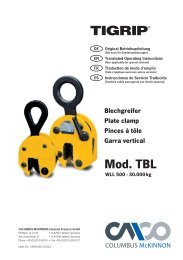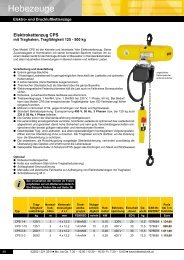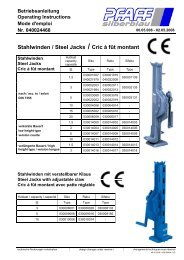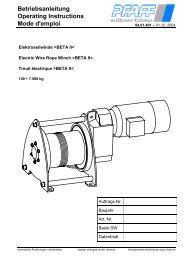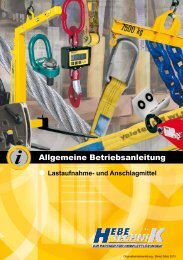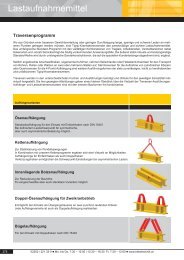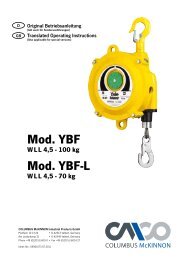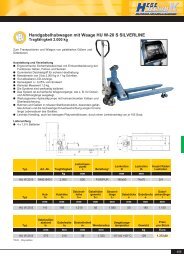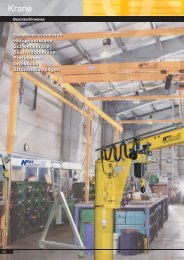Yalelift 360 ATEX - Carl Stahl
Yalelift 360 ATEX - Carl Stahl
Yalelift 360 ATEX - Carl Stahl
- Keine Tags gefunden...
Sie wollen auch ein ePaper? Erhöhen Sie die Reichweite Ihrer Titel.
YUMPU macht aus Druck-PDFs automatisch weboptimierte ePaper, die Google liebt.
Attention: The load lifting attachment mustbe suitable for the <strong>ATEX</strong> zone too.FUNCTION / OPERATIONAttaching the loadLoads should be attached by lashing ropes orlashing chains which are specifically adjustedto the load weight. Loads must not be attachedby using the load chain as a slinging device.The load must always be seated in the centreof the hook.Lifting the loadPulling the hand chain (Fig. 11) in clockwisedirection, the load will be raised.In order to avoid sparking, neither hand orload chain should bang or strike the floor orany other place.Note: If this is not possible, consult themanufacturer!Lowering the loadPulling the hand chain (Fig. 11) in anticlockwisedirection, the load will be slowly lowered.In order to avoid sparking, neither hand orload chain should bang or strike the floor orany other place.Note: If this is not possible, consult themanufacturer!Yale overload protection (optional)The overload protection device is set at approx.25% (±15%) overload.The adjustment of the overload protectiondevice must be carried out by a competentperson only.When exceeding the pre-set overload limit, theprotection device will be activated and preventfurther lifting of load.Pulling the hand chain in anticlockwise directionwill release the jammed protection deviceand permit smooth lowering of the load.DECOMMISsIONINGPutting out of service / storageIf the hoist has to be taken out of service fora longer period of time, hand and load chainsshould be protected against corrosion. For thispurpose, a light oil film should be appliedto the chains. The brake thread should belightly lubricated at the brake disc and at thedriving pinion, in order to avoid fixed corrosionof the brake.Note: At temperatures below 0°C the brakediscs can freeze! For this reason the hoistshould be stored after operation always withthe brake in closed position. For this purposeturn the hand wheel in clockwise directionand simultaneously hold the carrying loadchain strand.INSPECTION, MAINTENANCE ANDREPAIRInspections are instigated by the user.Maintenance and inspectionInspections should be carried out at leastannually by a competent person. Adverseoperating conditions may dictate shorterinspection periods. The inspections are mainlyvisual and functional and shall establish thatthe components of the hoist are in perfectcondition and do not show signs of damage,wear, corrosion or other irregularities. All safetydevices are to be checked for completenessand effectiveness. Initial operation and recurringinspections should be registered in theattached Yale works certificate of compliance.Also consult the maintenance and inspectionintervals on page 17.Spare partsRepairs may only be carried out by specialistworkshops that use original Yale spare parts!Check brake functionThe daily brake inspection should be madeas follows:- Attach a small load, raise over a shortdistance and lower again.- During this process let the hand chain goseveral times.The load must be held perfectly and must notkeep on running.Attention: Should the load chain keep onrunning, stop using the hoist immediately andconsult the manufacturer.LubricantsIn order to reduce wear, the load chain shouldbe lubricated from time to time with a chainspray lubricant or machine oil. Gear train andbrake winding should be greased in disassembledcondition as well.Attention: The brake winding should be lubricatedslightly only, in order to avoid contact ofthe lub with the friction discs.Range of application/lubricantBrake winding: Teccem e.K. 708WPlus NeuChain lubrication: Shell Tonna T68,Rocol M070,Rocol MV 3Gearbox and bearingseat lubrication: Gleitmo 805K,Dropping point > 130°C7INSPECTION PRIOR TO INITIALOPERATIONEach unit must be inspected prior to initialoperation by a competent person. The inspectionis mainly visual and functional and shallestablish that the product is in safe and perfectcondition. Any signs of damage, wear, corrosionor other irregularities should be reportedand removed if necessary.Inspections should be made by a representativeof the manufacturer or the supplieralthough the company can assign its ownsuitably trained personnel.INSPECTION BEFORE STARTING WORKBefore starting work, inspect the hoistincluding chains(s) and all load carryingconstructions every time for visual defects anddeficiencies. Furthermore, test the brake andmake sure that the load and hoist are correctlyattached. For this purpose a short work cycleof lifting/pulling or tensioning and releasingshould be carried out .Note: At ambient temperatures below 0°C,the brake discs may freeze: In this case suspendthe hoist according to instruction with aload attached. Start lifting the load slowly untilthe load chain is under tension. Now removethe tension by pulling at the hand chain.Repeat this process twice before startingfurther operation.Inspection of top and bottom hooksInspect the top and bottom hooks for deformation,damage, cracks, wear and corrosionmarks at least once per year.Adverse applications may dictate shorterinspection intervals. Hooks, which have beenrejected during inspection, must be replacedby new ones. Welding on load hooks, e.g. toadjust for wear, is not permissible. Load hooksmust be replaced, if the mouth opening iswidened by 10% (see Fig. 14) or the nominaldimensions have been reduced by 5% onaccount of wear. Nominal dimensions andwear limits are given in table 3 below. Whenexceeding the following limits, the componentshave to be replaced.Load chain inspectionThe load chain has to be inspected for mechanicaldefects annually, however, latest after50 hours of operation.The load chain has to be checked for visualdamages, deformations, cracks, corrosionmarks, wear and sufficient lubrication.Link chains have to be replaced, when theoriginal nominal dimension ´d´ at the strongestworn chain link has been reduced by morethan 10% or when the chain has experienced



